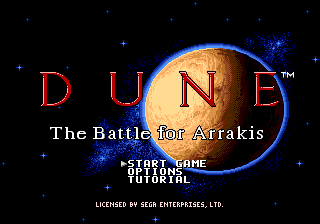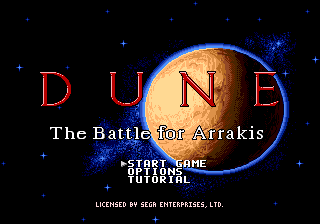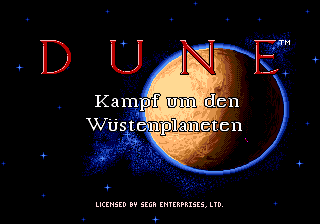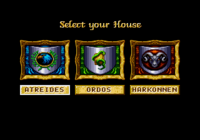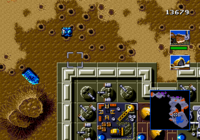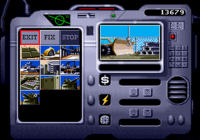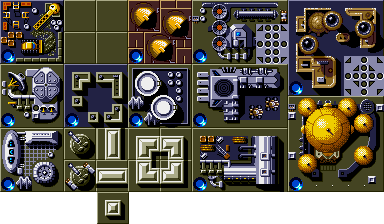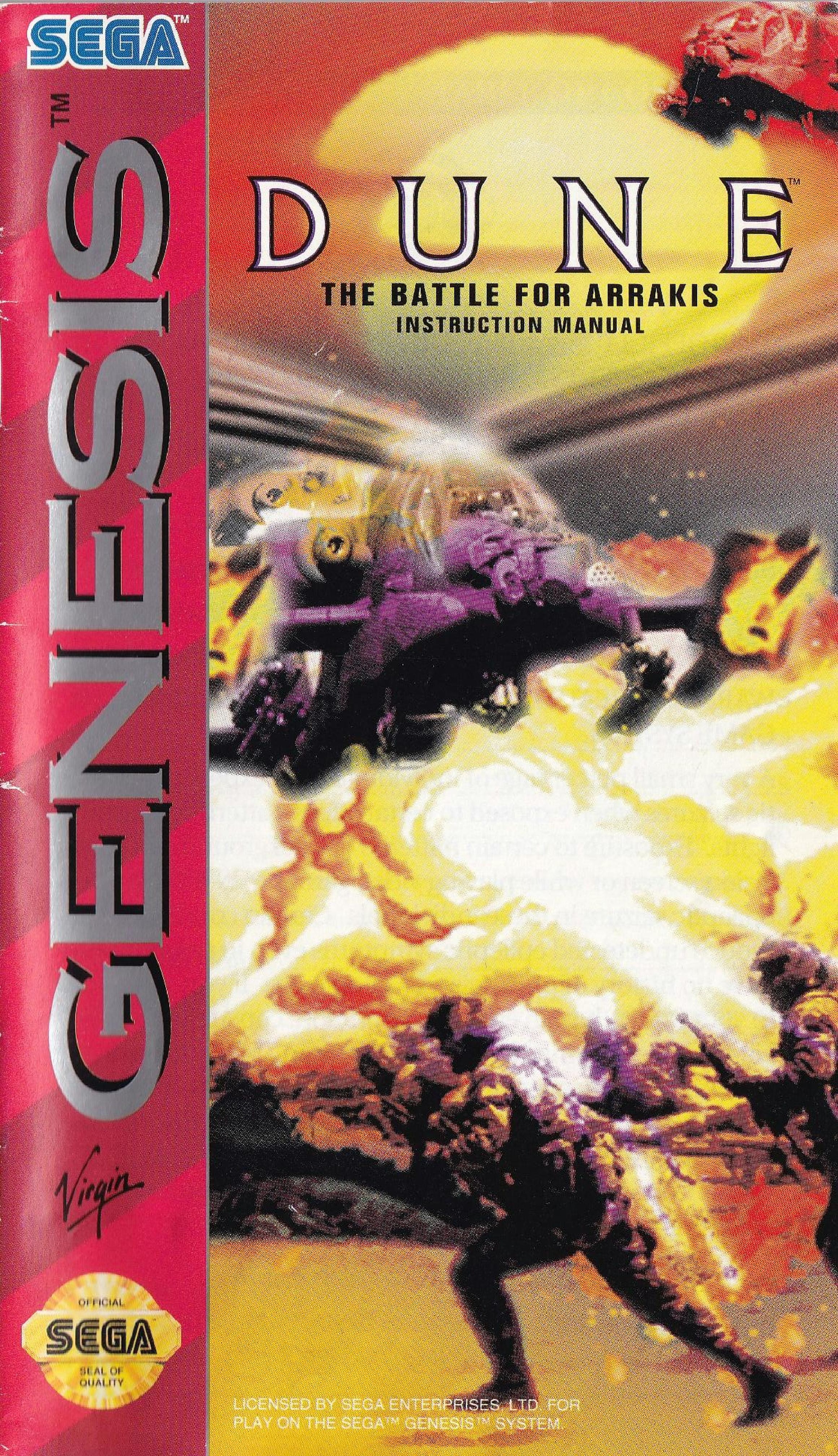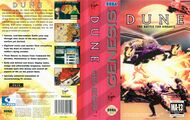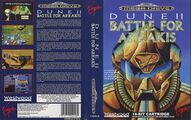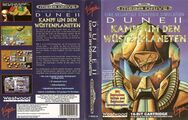Dune II: Battle for Arrakis
From Sega Retro
- For the Sega Mega-CD game, see Dune.
| ||||||||||||||||||||||||||||||
| Dune II: Battle for Arrakis | ||||||||||||||||||||||||||||||
|---|---|---|---|---|---|---|---|---|---|---|---|---|---|---|---|---|---|---|---|---|---|---|---|---|---|---|---|---|---|---|
| System(s): Sega Mega Drive | ||||||||||||||||||||||||||||||
| Publisher: Virgin Interactive Entertainment | ||||||||||||||||||||||||||||||
| Developer: Westwood Studios | ||||||||||||||||||||||||||||||
| Licensor: Dino De Laurentis, MCA/Universal Merchandising | ||||||||||||||||||||||||||||||
| Sound driver: GEMS | ||||||||||||||||||||||||||||||
| Genre: Simulation | ||||||||||||||||||||||||||||||
| Number of players: 1 | ||||||||||||||||||||||||||||||
| Official in-game languages: | ||||||||||||||||||||||||||||||
|
Dune II: Battle for Arrakis, known as Dune: The Battle for Arrakis in the US, is a strategy game developed by Westwood Studios and published by Virgin Interactive Entertainment for the Sega Mega Drive. The game was also translated to German as Dune II: Kampf um den Wüstenplaneten. It was one of the first, if not first, Sega Mega Drive game to feature fully localized, spoken German language audio.
Battle for Arrakis is a complete overhaul of Dune II: The Building of a Dynasty, a game released for the IBM PC and Amiga a year earlier. The Mega Drive version features streamlined controls, gameplay tweaks, new levels, and new graphics. Dune II is considered a milestone in the real-time strategy genre.
Contents
Story
The story of Dune II is slightly different than the official canon of the Dune universe. None of the characters from the book are mentioned and a new House called "Ordos," created by Westwood Studios, is available for play.
The Emperor of the Galaxy, Frederick IV of House Corrino, is desperate for the harvesting of a powerful life-prolonging substance called the "spice" to pay off all of his debt incurred on internecine wars with family members. To achieve this, he declares an open challenge to all powerful Houses in the galaxy and announces that the victorious House will take control of Arrakis, also known as "Dune," the only planet in the universe where the spice can be mined. He states that there will be no rules of engagement.
The player is a military commander from a House of their choice. In the first few missions, the objectives are to successfully establish a base on an unoccupied territory of Arrakis, to harvest spice, and to defeat intruders. Later, when the three Houses divide Arrakis among them, the player has to assault and capture enemy territories. When the player dominates Arrakis on the world map, the two other enemy factions ally against their common enemy. The final showdown is the battle between the player's House against three enemy sides, among them Frederick's forces, the Sardaukar (an unplayable elite force whose heavy infantry are particularly powerful).
House Atreides
Hailing from the beautiful planet of the Caladan, the people of House Atreides are known for their hardworking, peace-loving and dedicated nature. House Atreides believes an alliance with the local inhabitants of Dune, the Fremen, is the only way to establish rule over the Dune. The Noble House of Atreides is known for its tendency to negotiate with their opponents first, a tactic that will most likely fail in Dune.
In game, House Atreides focuses on technological superiority. While they cannot produce Heavy Troopers, they are able to deploy Ornithopters, giving them some amount of air power. Their special weapon is the Sonic Tank and their ultimate special weapons are the Fremen.
House Ordos
A House created solely for this game, House Ordos is not actually a noble House at all. It is a loosely allied group of merchants whose armies consist of mercenaries. They do not produce any weapons, instead purchasing what they need to send into combat. This insidious House believes that profits are everything and will stop at nothing until the profitable spice-mining business is completely under their control.
House Ordos cannot produce Quads, Trikes, and Rocket Launchers. Their special unit is the Deviator and their ultimate weapon is the Saboteur. They can also produce Ornithopters, but they develop them much later compared to the Atreides.
House Harkonnen
The most vile and violent House in the universe, House Harkonnen believes that power is everything. Their desire is to take control of the Dune and take revenge from their hated enemy, House Atreides, drives them forward in their conquest of Dune. In House Harkonnen, power is never given; it is taken. If a soldier kills his commander and takes command, he is respected and feared by all.
House Harkonnen specializes in heavy weaponary. They do not produce Trikes and light infantry. Their special weapon is the Devastator and their ultimate weapon is the Death Hand missile.
Gameplay
The player takes the role of the commander of one of the three interplanetary Houses, the Atreides, the Harkonnen, or the Ordos, with the objective of wresting control of Arrakis from the other two Houses. The objective of most missions is usually to destroy all enemy units and structures on the map. The basic strategy in the game is to harvest spice from the treacherous sand dunes using a harvester vehicle, convert the spice into credits via a refinery, and build military units with these acquired credits in order to fend off and destroy the enemy. The game map initially starts with a fog of war covering all area which is not covered by the player's units range of view. As the units explore the map, the darkness is removed. Unlike later games such as Warcraft II, the fog of war is lifted forever with initial exploration; it does not become dark once more when units leave the area.
In addition to enemy incursions, there are other dangers such as the marauding, gigantic sandworm, capable of swallowing vehicles and infantry whole but blocked by rocky terrain. Buildings may only be built in rocky zones and connected to another existing building. Building structures or units requires spice, which can be harvested at various points on the map. Spice fields are indicated by orange coloration on the sand, darker orange indicating high concentration. Spice can be spent fixing structures or gained by selling them. Buildings require power to function, so the player must build and defend Windtraps to generate power. When the player's base has insufficient power, buildings cannot start production on new units, and units already in production are produced much more slowly.
The Construction Yard can produce new buildings, while the Barracks and Vehicle Factories can produce infantry and vehicles respectively. Completing higher missions unlocks improved technology and higher-order weaponry unique to each House. For example, House Harkonnen may construct their Devastator tanks with heavy armor and ordnance but cannot build the similarly impressive Atreides Sonic Tank or the Ordos Deviator tanks. The player can gain access to other Houses' special units by capturing an enemy Vehicle Factory. The final prize for the commander is the building of the House Palace from where superweapons may be unleashed on opponents in the final closing chapters of the game. The House Harkonnen superweapon is a long-range powerful but inaccurate finger of missiles called the Death Hand, whereas House Atreides may call upon the local Fremen infantry warriors, over which the player has no control, to engage enemy targets. House Ordos may unleash a fast-moving Saboteur whose main purpose is the destruction of buildings.
In its original home computer form, Dune II was entirely mouse-driven; however, the Mega Drive version only supports the control pad. The game includes a tutorial to familiarize the player with the controls and the basic mechanics. The D-Pad moves a cursor, which is used to select units and structures or pan the view (when moved near the edges of the screen). Holding ![]() while moving the D-Pad quickly pans the screen without moving the cursor. The player can select units by pressing
while moving the D-Pad quickly pans the screen without moving the cursor. The player can select units by pressing ![]() or cancel a selection by pressing
or cancel a selection by pressing ![]() . Only one unit or structure can be selected at a time. Units automatically fire on enemy units within range but can be commanded to move to specific locations or target specific units. When a unit is selected, the selection cursor changes to a targeting cursor, and the player can give an order to move (when the cursor is over terrain) or attack (when the cursor is over an enemy unit) by pressing
. Only one unit or structure can be selected at a time. Units automatically fire on enemy units within range but can be commanded to move to specific locations or target specific units. When a unit is selected, the selection cursor changes to a targeting cursor, and the player can give an order to move (when the cursor is over terrain) or attack (when the cursor is over an enemy unit) by pressing ![]() .
.
The production screen can be seen by moving the cursor over a building, then pressing ![]() twice. This screen shows a menu where the player can choose a unit or structure that can be produced. Unlike later Command & Conquer games, each building can only construct one thing at a time. Each unit has a cost (in credits), an armament (showing the damage done to other units), and shielding (showing the damage that the unit can withstand). Credits are spent as units are produced (rather than taken upfront when the unit begins production). Units and structures take time to produce; their progress is shown on the side of the screen when their production structure is selected. When a building is finished constructing, a placement grid appears over the player's cursor, allowing the player to place the building in any valid location. Production can be halted from the production screen by selecting "Stop." The player can also repair buildings to restore any damage taken by enemy attacks by selecting "Fix" (which pauses production).
twice. This screen shows a menu where the player can choose a unit or structure that can be produced. Unlike later Command & Conquer games, each building can only construct one thing at a time. Each unit has a cost (in credits), an armament (showing the damage done to other units), and shielding (showing the damage that the unit can withstand). Credits are spent as units are produced (rather than taken upfront when the unit begins production). Units and structures take time to produce; their progress is shown on the side of the screen when their production structure is selected. When a building is finished constructing, a placement grid appears over the player's cursor, allowing the player to place the building in any valid location. Production can be halted from the production screen by selecting "Stop." The player can also repair buildings to restore any damage taken by enemy attacks by selecting "Fix" (which pauses production).
Each House has a separate campaign consisting of nine missions each. The game uses a password system for continuing. Passwords are entered from the options screen, which can be accessed from the main menu or invoked at any time during gameplay with START .
Structures
More advanced units and structures become available as the player progresses through each campaign.
Units
House Atreides units are blue, House Ordos units are green, and House Harkonnen units are red.
History
Development
According to designer Joseph B. Hewitt IV, Dune II was inspired by the games Populous, Herzog Zwei, and Civilization.[5]
Legacy
While not the first real-time strategy game, Dune II was one of the most influential games in the genre, particularly in the Command & Conquer series, also developed by Westwood Studios. Its specific combination of a fog of war, mouse-based military micromanagement, and an economic model of resource-gathering and base-building established a template for subsequent real-time strategy games, including the Warcraft and StarCraft series from Blizzard Entertainment and the Age of Empires series from Microsoft.
In 1998, Dune II was remade for Windows PCs as Dune 2000, which was ported to the PlayStation. In 2001, Westwood released a sequel, Emperor: Battle for Dune, exclusively for PCs.
Production credits
- Executive Producer: Christopher D. Yates
- Producers: Aaron E. Powell, David Pokorny
- Product Coordinators: Robb Alvey, Ken Love
- Designed by: Aaron E. Powell, Joe Bostic
- Programmers: Leroy Wing, Denzil E. Long, Jr., Rob Povey
- Writer: Rick Gush
- Artists: Matthew Hansel, Sandy Dobbs
- Music & Sound: Paul S. Mudra, Frank Klepacki, Dwight K. Okahara
- Voices: Frank Klepacki, House Voices; Glenn Sperry, Units
- Manual: Eydie Laramore
- Manual Layout: Penina Finger
- Quality Assurance: Glenn Sperry, Mike McCaa, Adam Ryan, Kenny Dunne, Paul Schoener, William Baca, Jesse Clemit, Jeff Fillhaber, Scott Fleming, Bill Foster, Mike Lightner, Tim Fritz, Ronnie Balducci, Jared Brinkley, Mitch Feldman, Chris McFarland, Scott Manning, David Fries, Chris Rausch, Nick Camerota, Bijan Shaheer
- Package Design & Fulfillment: Lauren Rifkin, Lisa Marcinko
- Special Thanks to: Brett W. Sperry and Lyle J. Hall II
- Dune is a trademark of Dino De Laurents Corporation and licensed by MCA/Universal Merchandising, Inc. ©1984 Dino De Laurents Corporation. All Rights Reserved.
- ©1993 Westwood Studios, Inc. All Rights Reserved.
- Virgin is a registered trademark of Virgin Enterprises, LTD.
- Thank you for playing Dune: The Battle for Arrakis
Magazine articles
- Main article: Dune II: Battle for Arrakis/Magazine articles.
Promotional material
Physical scans
| 88 | |
|---|---|
| Based on 41 reviews | |
| Mega Drive, AU |
|---|
|
Technical information
- Main article: Dune II: Battle for Arrakis/Technical information.
References
- ↑ 1.0 1.1 1.2 Game Players, "Vol. 7 No. 3 March 1994" (US; 1994-0x-xx), page 52
- ↑ 2.0 2.1 Mega, "June 1994" (UK; 1994-05-19), page 81
- ↑ 3.0 3.1 Mean Machines Sega, "January 1994" (UK; 1993-11-30), page 128
- ↑ 4.0 4.1 Sega Power, "January 1994" (UK; 1993-12-02), page 56
- ↑ https://working-as-designed.blogspot.com/2011/12/birth-of-first-real-time-strategy-game.html (Wayback Machine: 2023-11-23 08:12)
- ↑ File:Dune2 MD US Manual.pdf, page 34
- ↑ EGM², "July 1994" (US; 1994-07-19), page 61
- ↑ EGM², "August 1994" (US; 1994-0x-xx), page 53
- ↑ Electronic Gaming Monthly, "September 1994" (US; 1994-xx-xx), page 79
- ↑ 1700 igr dlya Sega, "" (RU; 2001-xx-xx), page 64
- ↑ Aktueller Software Markt, "Januar 1995" (DE; 1994-12-05), page 30
- ↑ Console Mania, "Gennaio 1994" (IT; 199x-xx-xx), page 52
- ↑ Consoles +, "Mai 1994" (FR; 1994-0x-xx), page 106
- ↑ Cool Gamer, "9" (RU; 2002-10-13), page 69
- ↑ Computer & Video Games, "January 1994" (UK; 1993-12-15), page 84
- ↑ Digitiser (UK) (1994-06-07)
- ↑ Electronic Gaming Monthly, "January 1994" (US; 199x-xx-xx), page 44
- ↑ Entsiklopediya luchshikh igr Sega. Vypusk 1, "" (RU; 1999-xx-xx), page 94
- ↑ GamePro, "December 1993" (US; 1993-xx-xx), page 83
- ↑ Gamers, "Mai/Juni 1994" (DE; 1994-05-06), page 22
- ↑ GamesMaster (UK) "Series 3, episode 8" (1993-10-28, 24:00) (+7:53)
- ↑ Games World: The Magazine, "July 1994" (UK; 1994-05-26), page 16
- ↑ Game Informer, "May/June 1994" (US; 1994-0x-xx), page 10
- ↑ Hyper, "March 1994" (AU; 1994-xx-xx), page 47
- ↑ Joypad, "Mai 1994" (FR; 1994-0x-xx), page 128
- ↑ Joypad, "3/1994" (HU; 1994-xx-xx), page 16
- ↑ MAN!AC, "04/94" (DE; 1994-03-09), page 48
- ↑ Mega, "January 1994" (UK; 1993-12-16), page 52
- ↑ Mega Action, "January 1994" (UK; 1993-12-30), page 16
- ↑ Mega Force, "Mai 1994" (FR; 1994-0x-xx), page 62
- ↑ Mega Fun, "05/94" (DE; 1994-04-20), page 100
- ↑ Mega Machines, "January 1994" (UK; 1993-12-09), page 72
- ↑ Mega Play, "February 1994" (US; 199x-xx-xx), page 46
- ↑ MegaTech, "January 1994" (UK; 1993-12-21), page 68
- ↑ Player One, "Mai 1994" (FR; 1994-0x-xx), page 78
- ↑ Play Time, "6/94" (DE; 1994-05-04), page 128
- ↑ Power Up!, "Saturday, June 11, 1994" (UK; 1994-06-11), page 1
- ↑ Power Unlimited, "Jaargang 2, Nummer 5, Mei 1994" (NL; 1994-04-27), page 32
- ↑ Sega Magazine, "January 1994" (UK; 1993-12-10), page 120
- ↑ Sega Pro, "February 1994" (UK; 1993-12-30), page 32
- ↑ Sega Zone, "January 1994" (UK; 1993-12-23), page 62
- ↑ Sega Mega Drive Review, "1" (RU; 1995-04-03), page 46
- ↑ Sonic the Comic, "June 24th 1994" (UK; 1994-06-11), page 10
- ↑ Todo Sega, "Febrero 1994" (ES; 1994-0x-xx), page 38
- ↑ Tricks 16 bit, "Tricks Sega Gold 800 igr" (RU; 1998-03-20), page 12
- ↑ Video Games, "3/94" (DE; 1994-02-23), page 88
- ↑ Video Games, "6/94" (DE; 1994-05-25), page 97
| Dune II: Battle for Arrakis | |
|---|---|
|
Main page | Comparisons | Maps | Passwords | Hidden content | Magazine articles | Video coverage | Reception | Region coding | Technical information | Bootlegs
Prototypes: 1994-01-11
| |
| Dune games for Sega systems | |
|---|---|
| Dune (1993) | |
| Dune II: Battle for Arrakis (1994) | |
- 1 player games
- US Mega Drive games
- All US games
- EU Mega Drive games
- All EU games
- DE Mega Drive games
- All DE games
- UK Mega Drive games
- All UK games
- AU Mega Drive games
- All AU games
- Mega Drive games
- 1994 Mega Drive games
- All 1994 games
- Mega Drive simulation games
- All simulation games
- All games
- Dune II: Battle for Arrakis
- Dune (franchise)
